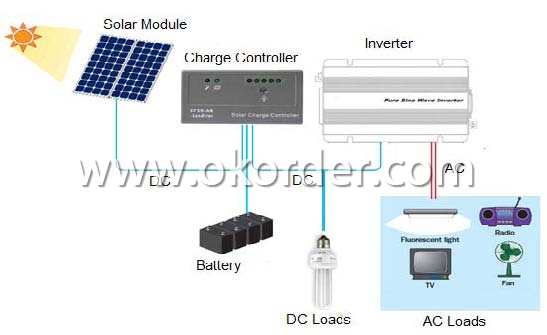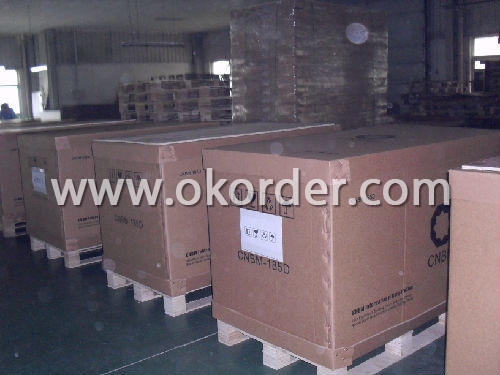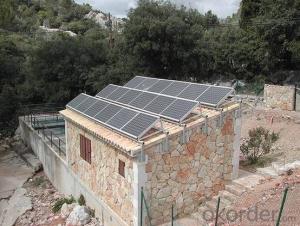CNBM Solar Home System CNBM-K9 (10KW)
- Loading Port:
- China Main Port
- Payment Terms:
- TT or L/C
- Min Order Qty:
- 1 set set
- Supply Capability:
- 1000 sets per month set/month
OKorder Service Pledge
OKorder Financial Service
You Might Also Like
Brief Introduction of Solar Energy System CNBM-K9 (10KW)
CNBM Home System-K9 (10KW) has a wonderful capacity.It can be used in factory,home,school and other CNBM Home System-K9 (10KW) consist of the solar modules,charge controller,inverter and battery banks.
CNBM International is highly recognized by its business partners and clients all over the world and has obtained rapid development under the spirit of win-win .
With CNBM Home System-K9 (10KW),
We will carry on the mutual beneficial,innovative and revolutionary trading structure as we did before,create value for our employees,share holders and clients and benefit the whole society in our future development.Please contact us ,if you have interest in CNBM Home System-K9 (10KW),don’t hesitate!
The Sketching of Solar Energy System CNBM-K9 (10KW)

Components of Solar Energy System CNBM-K9 (10KW)
PV Array:
Convert sunlight instantly into DC electric power. Formed by the solar modules (also called photovoltaic modules) in accordance with the system requirements for series and parallel.
Solar Charge Controller:
A charge controller may be used to power DC equipment with solar panels. The charge controller provides a regulated DC output and stores excess energy in a battery as well as monitoring the battery voltage to prevent over charge or over discharge. An inverter can be connected to the output of a charge controller to drive AC loads.
Inverter:
Converts DC output power of photovaltaic soalr panels into standard AC power for use in the local off-grid electrical network. It is a critical component in a photovoltaic system, allowing the use of ordinary commercial appliances.
Battery banks:
Stores energy when there is an excess coming in and distribute it back out when there is a demand. Solar PV panels continue to re-charge batteries each day to maintain battery charge.
Technical data of Solar Home System CNBM-K9 (10KW) | ||
Inverter | Rated load power | 10KW |
Output wave | Pure sine wave | |
Output voltage | DC 220V | |
Output frequency |
AC:220V | |
Precision of output | 50HZ/60HZ | |
Precision of output frequency | ±0.04HZ | |
Solar panel | Pmax | 200W*55PCS |
Vmp | 26.84V*11 | |
Imp | 7.45A*5 | |
Charger | Charger voltage & current | 220V /50A |
Battery | Capacity | 12V /150AH*18*2PCS |
Support | Aluminum | 11PCS/SET*5 |
Power box | Spray paint iron box,with input,output,ammeter,voltmeter,master swith and so on. | |
Package of Solar Home System CNBM-K9 (10KW) | ||||
Part | Size(L*W*H mm) | Weight(kg) | 20’(pcs) | 40’(pcs) |
Power box | 500*550*1500 | 190 | 6 Sets | 8 Sets |
Solar panel | 1482*992*40 | 960 | ||
Battery | 1100*520*650*4 | 2200 | ||
Factory Picture of Solar Energy System CNBM-K9 (10KW)

Package Picture of Solar Energy System CNBM-K9 (10KW)

- Q:Can a solar energy system be installed in areas prone to hailstorms?
- Yes, solar energy systems can be installed in areas prone to hailstorms. However, it is essential to consider certain factors to ensure their durability and resilience against hail damage. This includes using high-quality materials, such as tempered glass for solar panels, and proper installation techniques. Additionally, some solar panels are specifically designed to withstand hail and extreme weather conditions, providing further protection.
- Q:Can solar energy systems be used in powering recycling plants or waste management facilities?
- Yes, solar energy systems can certainly be used to power recycling plants and waste management facilities. Solar panels can be installed on the roofs or in open spaces of such facilities to generate electricity from sunlight. This renewable energy source can help reduce reliance on fossil fuels and lower the carbon footprint of these operations. Additionally, solar energy can provide a stable and consistent power supply, contributing to the overall sustainability and efficiency of recycling plants and waste management facilities.
- Q:Can solar energy systems be used for powering off-grid eco-lodges?
- Yes, solar energy systems can be effectively used for powering off-grid eco-lodges. Solar panels can be installed on the roofs of eco-lodges to harness the energy from the sun and convert it into electricity. This renewable source of energy can then be used to power various electrical appliances, lighting, heating, and cooling systems in the eco-lodges. Additionally, solar energy systems can also incorporate battery storage to store excess energy for use during cloudy or nighttime conditions. This sustainable solution not only reduces the reliance on fossil fuels but also minimizes the environmental impact of off-grid accommodations.
- Q:Can solar energy systems be used in residential buildings?
- Yes, solar energy systems can be used in residential buildings. They are increasingly being installed in homes to generate electricity and heat water, reducing reliance on traditional energy sources and lowering electricity bills.
- Q:Can solar energy systems be used in areas with heavy snowfall?
- Yes, solar energy systems can be used in areas with heavy snowfall. However, it is important to design and install the system properly to account for the snow load and ensure maximum efficiency. Additionally, regular maintenance and snow removal may be required to optimize performance during winter months.
- Q:Are solar energy systems suitable for commercial buildings?
- Yes, solar energy systems are suitable for commercial buildings. They offer numerous benefits such as reduced energy costs, increased energy efficiency, and a positive environmental impact. Additionally, solar panels can be easily installed on rooftops or as ground-mounted systems, making them a viable option for various types of commercial buildings.
- Q:What are the maintenance requirements for solar energy systems?
- Solar energy systems require minimal maintenance. The main maintenance requirements include regularly cleaning the solar panels to remove dust and debris, checking the connections and wiring for any signs of damage or wear, and monitoring the system's performance to ensure it is generating the expected amount of electricity. Additionally, the inverter, which converts the solar energy into usable electricity, may need to be replaced after around 10-15 years. Overall, with proper maintenance, solar energy systems can last for several decades with little to no issues.
- Q:Can solar energy systems be used in areas with limited space on rooftops due to existing equipment or structures?
- Yes, solar energy systems can still be used in areas with limited space on rooftops due to existing equipment or structures. In such cases, alternative solutions can be employed to maximize the utilization of available space. One option is to install solar panels on ground-mounted systems instead of rooftops. These systems can be placed in open areas adjacent to buildings or even on unused land nearby. Additionally, solar canopies or awnings can be installed in parking lots or other open spaces to generate solar power. These structures can be designed to provide shade and shelter while simultaneously harnessing solar energy. Thus, even in areas with limited rooftop space, there are various creative options available to implement solar energy systems.
- Q:What is the impact of shading on the performance of solar panels?
- Shading has a significant impact on the performance of solar panels. When any part of a solar panel is shaded, it reduces the amount of sunlight that reaches the cells, resulting in a decrease in energy production. This is because solar panels operate by converting sunlight into direct current (DC) electricity through the photovoltaic effect. When a solar panel is partially shaded, it creates what is known as a "hotspot effect." This occurs when shaded cells within a panel become a high-resistance pathway for the flow of electricity, leading to a localized increase in temperature. This increased heat can degrade the performance of the entire panel and reduce its overall efficiency. Furthermore, shading also affects the panel's overall voltage and current output. Solar panels are typically connected in series to increase the output voltage. However, if even a single panel is shaded, it can significantly reduce the performance of the entire series-connected string. This is because the shaded panel acts as a bottleneck, limiting the current flow through the entire string. To mitigate the impact of shading, various solutions can be implemented. One common approach is to use bypass diodes, which allow the current to flow around the shaded cells, preventing the hotspot effect. By incorporating bypass diodes, the energy loss due to shading can be minimized, ensuring that the rest of the solar panel continues to operate efficiently. Additionally, proper design and placement of solar panels can also help reduce the effects of shading. Installing solar panels in areas with minimal obstructions or shadows, such as rooftops or open fields, can maximize their exposure to sunlight. Regular maintenance, including trimming nearby trees or vegetation that may cast shadows, is also important to ensure optimal performance. In conclusion, shading has a significant impact on the performance of solar panels, leading to reduced energy production and efficiency. Understanding and addressing shading issues through the use of bypass diodes and careful installation can help maximize the output and effectiveness of solar panel systems.
- Q:Are solar energy systems scalable for different energy needs?
- Yes, solar energy systems are scalable for different energy needs. They can be designed and tailored to meet the specific energy requirements of residential, commercial, or industrial applications. The size and capacity of solar panels, inverters, and battery storage systems can be adjusted to match the desired energy output, making solar energy a flexible and scalable solution for a wide range of energy needs.
1. Manufacturer Overview |
|
|---|---|
| Location | Ningbo,China |
| Year Established | 2004 |
| Annual Output Value | Above US$0.3 Billion |
| Main Markets | Australia;Europe. |
| Company Certifications | ISO9001:2008;VDE;CE |
2. Manufacturer Certificates |
|
|---|---|
| a) Certification Name | |
| Range | |
| Reference | |
| Validity Period | |
3. Manufacturer Capability |
|
|---|---|
| a)Trade Capacity | |
| Nearest Port | Ningbo |
| Export Percentage | 0.4 |
| No.of Employees in Trade Department | 10 People |
| Language Spoken: | English;Chinese; |
| b)Factory Information | |
| Factory Size: | Above 4,000 square meters |
| No. of Production Lines | Above 5 |
| Contract Manufacturing | OEM Service Offered;Design Service Offered |
| Product Price Range | Average |
Send your message to us
CNBM Solar Home System CNBM-K9 (10KW)
- Loading Port:
- China Main Port
- Payment Terms:
- TT or L/C
- Min Order Qty:
- 1 set set
- Supply Capability:
- 1000 sets per month set/month
OKorder Service Pledge
OKorder Financial Service
Similar products
New products
Hot products
Hot Searches
Related keywords





























